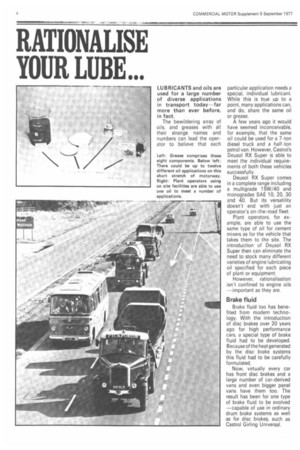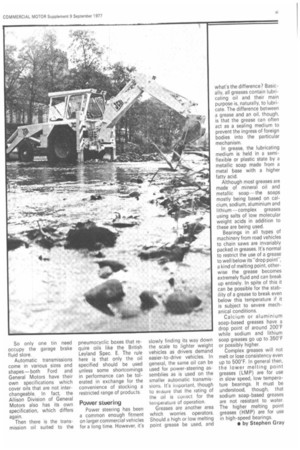RATIONALISE YOUR LUBE...
Page 58

Page 59

If you've noticed an error in this article please click here to report it so we can fix it.
LUBRICANTS and oils are used for a large number of diverse applications in transport today—far more than ever before, in fact.
The bewildering array of oils, and greases with all their strange names and numbers can lead the operator to believe that each particular application needs a special, individual lubricant. While this is true up to a point, many applications can, and do, share the same oil or grease.
A few years ago it would have seemed inconceivable, for example, that the same oil could be used for a 7-ton diesel truck and a half-ton petrol van. However, Castrol's Deusol RX Super is able to meet the individual requirements of both these vehicles successfully.
Deusol RX Super comes in a complete range including a multigrade 15W/40 and monogrades SAE 10, 20, 30 and 40. But its versatility doesn't end with just an operator's on-the-road fleet.
Plant operators, for example, are able to use the same type of oil for cement mixers as for the vehicle that takes them to the site. The introduction of Deusol RX Super then can eliminate the need to stock many different varieties of engine lubricating oil specified for each piece of plant or equipment.
However, rationalisation isn't confined to engine oils —important as they are.
Brake fluid
Brake fluid too has benefited from modern technology. With the introduction of disc brakes over 20 years ago for high performance cars, a special type of brake fluid had to be developed. Because of the heat generated by the disc brake systems this fluid had to be carefully formulated.
Now, virtually every car has front disc brakes and a large number of car-derived vans and even bigger panel vans have them too. The result has been for one type of brake fluid to be evolved —capable of use in ordinary drum brake systems as well as for disc brakes, such as Castrol Girling Universal. So only one tin need occupy the garage brake fluid store.
Automatic transmissions come in various sizes and shapes—both Ford and General Motors have their own specifications which cover oils that are not interchangeable. In fact, the Allison Division of General Motors also has its own specification, which differs again.
Then there is the transmission oil suited to the pneumocyclic boxes that require oils like the British Leyland Spec, E. The rule here is that only the oil specified should be used unless some shortcomings in performance can be tolerated in exchange for the convenience of stocking a restricted range of products.
Power steering
Power steering has been a common enough fitment on larger commercial vehicles for a long time. However, it's slowly finding its way down the scale to lighter weight vehicles as drivers demand easier-to-drive vehicles. In general, the same oil can be used for power-steering assemblies as is used on the smaller automatic transmissions. It's important, though to ensuie that the rating of the oil is coirect for the temperature of operation.
Greases are another area which worries operators. Should a high or low melting point grease be used, and what's the difference? Basically, all greases contain lubricating oil and their main purpose is, naturally, to lubricate. The difference between a grease and an oil, though, is that the grease can often act as a sealing medium to prevent the ingress of foreign bodies into the particular mechanism.
In grease, the lubricating medium is held in a semiflexible or plastic state by a metallic soap made from a metal base with a higher fatty acid.
Although most greases are made of mineral oil and metallic soap—the soaps mostly being based on calcium, sodium, aluminium and lithium —complex greases using salts of low molecular weight acids in addition to these are being used.
Bearings in all types of machinery from road vehicles to chain saws are invariably packed in greases. It's normal to restrict the use of a grease to well below its "drop point", a kind of melting point, otherwise the grease becomes extremely fluid and can break up entirely. In spite of this it can be possible for the stability of a grease to break even below this temperature if it is subject to severe mechanical conditions.
Calcium or aluminium soap-based greases have a drop point of around 200F while sodium and lithium soap greases go up to 350°F or possibly higher.
Complex greases will not melt or lose consistency even up to 500°F. In general then, the lower melting point greases (LNIP) are for use in slow speed, low temperature bearings. It must be understood, though, that sodium soap-based greases are not resistant to water. The higher melting point greases (HMP) are for use in high-speed bearings.
• by Stephen Gray
















































































































